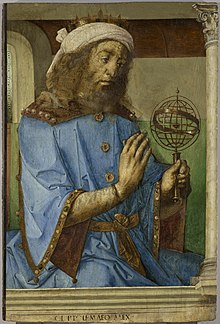佩德罗.贝鲁格特Berruguete, Pedro
佩德罗.贝鲁格特Berruguete, Pedro(1450年—1504年),西班牙画家。
工作
第一阶段
托勒密与一个浑天仪模型,通过乔斯·根特1476年,佩德罗Berruguete罗浮宫、巴黎
作品从他的第一阶段(1470年至1471年)包括验证教会的基督的十字架圣胡安裴瑞兹·德·德·纳瓦和麦琪的崇拜阿尔瓦雷斯Fisa集合。因为他的早期作品缺乏文档,他后来的日期估计风格的转变。这个简短的介绍阶段,是由于他年轻的时候在这段时间,可能他怀疑意大利之旅。
基督的十字架的面板验证描述2从十字架的故事真正的场景和4的布道者。麦琪的崇拜被认为是最古老的作品之一。
这些早期的绘画有数据比现实更简化他的后期和详细数据。他的签名使用提花设计,装饰和建筑空间的使用在绘画,但经济衰退的间和使用的角度看起来尴尬和他现实的人物看起来小于他改进后的数据在第三阶段的风格。
第二阶段(1471 - 1483)
在他的第二阶段推测他在意大利旅行。几乎没有文档工作的Berruguete这时,作者也有争议。费德里科••蒙特非凡的画像和他的儿子Guidobaldo(画廊的游行,乌尔比诺公爵的宫殿),和它的一系列名人的一部分(罗浮宫博物馆、巴黎和国家队广场,乌尔比诺)有时被归因于他虽然他们也归功于佛兰德画家贾斯特斯范绅士。[3][15]也可能是两位艺术家之间的合作与Berruguete工作系列,而在乌尔比诺凡根特工厂工作。[3][16]这个留在意大利会被打断了回程裴瑞兹·德·纳瓦在1478年结婚,之后他回到意大利。如果他确实去意大利旅行,这可以解释弗兰德和意大利文艺复兴风格的影响包括在他的卡斯提尔人艺术的第三个阶段。
第三阶段(1483 - 1503)
他的杰作是犹大诸王的绘画,特别是大卫王,坐落在高坛教会的圣尤拉莉亚德裴瑞兹·德·纳瓦)(帕伦西亚说明从圣母的生活场景,几个圣经国王的肖像。尽管古老的元素(额叶组成,黄金背景),他们是一个画廊的肖像强烈的现实主义。他创造了几个版本的诞生》和场景从她生活好几组塑,但是圣尤拉莉亚仍然是最著名的。这祭坛的装饰品是为数不多的可以肯定归因于Berruguete el桥通过文档。[17]
他最好的作品中可以看到不同地方的省份Palencia:麦琪的崇拜,报喜的圣玛丽教区的圣玛丽亚Becerril博物馆的德田;圣母的追求者和教区的受难,博物馆的帕伦西亚哀歌在基督的身体。教堂的帕伦西亚
在教堂的假设,Santa Maria del Campo(布尔戈斯)从这一时期保存两个重要作品:斩首的浸信会和基督的洗礼,形成了装饰画的一部分浸信会的生活,表在1483年至1485年之间,作为第一批第三阶段的工作。创新在成分和角度学习了在意大利在这两个作品很明显。
另一块Berruguete以创建在这个阶段是圣多米尼克主持一个宣判及执行,委托,最有可能的是,多米尼加修道院的一般严酷检察官托马斯·德·阿维拉的圣托马斯。[18]当西班牙宗教法庭还新,这幅画描述了一个宣判及执行仪式,或者一种信仰仪式,异教徒被折磨和处死。圣多米尼克的图,住在13世纪是穿着时下对15世纪西班牙和场景描述了同样的方式。[19]
Cartuja de报喜的米拉弗洛雷斯显著对象的细节和有趣的视角,创造一个完美的空间的错觉。这篇文章包含了西班牙北部的影响与现代风格的室内场景,据说是伊莎贝尔女皇委托的。[20]在所有这些数据是高度个性化的作品,和掌握空间、角度和构图是富含一种精确的设计和明智地使用色彩。
Berruguete的最后作业的高坛阿维拉大教堂,他无法完成,由于他的死亡。这项工作他画的晚期哥特式建筑几个绘画集与基督的生命的装饰画和数字的族长祭坛的台。这些画,或许反映出流行的风格在卡斯提尔,用黄金背景和有些僵硬的成分。更健壮的数据比以前作品的形式,也许为了脱颖而出的主要教堂的距离。主人死后完成了祭坛的装饰品Juan de Borgona.
Work
First stage
Works from his first stage (between 1470 and 1471) include Verification of the cross of Christ in the Church of San Juan de Paredes de Nava and the Adoration of the Magiin the Alvarez Fisa collection. Because his earlier works are lacking documentation, the dates are estimated by his later shift in style.[13] This short introductory phase of his is due to his young age during this time and possibly his suspected trip to Italy.
The panels for the Verification of the Cross of Christ depict 2 scenes from the story of the True Cross and 4 images of the Evangelists. The Adoration of the Magi is considered to be one of his oldest works.[14]
These early paintings have figures that are much more simplified than the realistic and detailed figures of his later stages. His signature use of brocade designs, gilding and the use of architectural spaces within painting are present, but the recession of space and use of perspective looks awkward and his figures look less realistic than the figures in his third stage after he refines his style.
Second stage (1471–1483)
In his second stage it is speculated that he travelled in Italy. There is little documentation of the work of Berruguete at this time, and there are controversies as to authorship. The remarkable Portrait of Federico da Montefeltro and his son Guidobaldo (Gallery of the Marches, Ducal Palace in Urbino), and the series of Famous Men of which it forms part (Louvre Museum, Paris and Galleria Nazionale, Urbino) are sometimes attributed to him although they are also attributed to the Flemish painter Justus van Gent.[3][15] It may also have been a collaboration between the two artists with Berruguete working on the series while working in van Ghent's workshop in Urbino.[3][16] This stay in Italy would have been interrupted by a return trip to Paredes de Nava in 1478 for marriage, after which he returned to Italy. If he indeed travel to Italy, this would explain the influence of Flemish and Italian Renaissance style inclusive in his third stage of Castilian art.
Third stage (1483–1503)
His masterpieces are the paintings of the kings of Judah, noting especially King David, which are situated on the high altar of the church of Santa Eulalia de Paredes de Nava (Palencia) illustrating scenes from the Life of the Virgin and portraits of several biblical kings. Despite archaic elements (frontal composition, gold background), they are a gallery of portraits of intense realism. He created several versions of the birth of the Virgin and scenes from her life for several retables, but the one at Santa Eulalia remains the most famous. This altarpiece is one of the few that can be certainly attributed to Berruguete el Viejo through documentation.[17]
Many of his best works can be seen in different localities of the province of Palencia: The Adoration of the Magi, The Annunciation of St. Mary in the parish of Santa Maria Museum of Becerril de fields; The Suitors of the Virgin and The Crucifixion in the Diocesan Museum of Palencia; The Lamentation over the body of Christ in the Cathedral of Palencia.
In the Church of the Assumption, Santa Maria del Campo (Burgos) are preserved two important works from this period:Beheading of the Baptist and the Baptism of Christ, which formed part of an altarpiece of the life of the Baptist, datable between 1483 and 1485, being among the first works of this third stage. Innovations in composition and perspective learned in Italy are evident in these two works.
Another piece that Berruguete is famous for creating during this stage is Saint Dominic Presiding over an Auto-da-fé,commissioned, most likely, by the General Inquisitor Tomás de Torquemada for the Dominican convent of Santo Tomás in Ávila.[18] Made when the Inquisition was still new to Spain, this painting depicted an Auto-da-fé ceremony, or an act of faith ceremony, where heretics were tortured and put to death. The figure of Saint Dominic, who lived in the 13th-century is dressed contemporarily for 15th-century Spain and the scene is depicted in the same manner
The Annunciation of the Cartuja de Miraflores is notable for the detail in objects and interesting set of perspectives, which creates a perfect illusion of space. This piece incorporates a northern influence with contemporary Spanish style in an interior scene and was supposedly commissioned by Queen Isabel In all these works the figures are highly individualized, and mastery of space, perspective and composition is enriched with an accurate sense of design and a wise use of color.
Berruguete's last assignment was the high altar of the Ávila Cathedral, which he was unable to finish due to his death. He painted for this work of late Gothic architecture several paintings of episodes from the life of Christ for the altarpiece, and figures of patriarchs for the predella. These paintings, perhaps reflecting the prevailing style in Castile at the time, use gold backgrounds and somewhat rigid compositions. The figures are of a more robust and monumental form than in previous works, perhaps in order to stand out in the distance of the main chapel. After the master's death the altarpiece was completed by Juan de Borgoña.
艺术官网信息声明
1、本站美术网信息均来自于美术家自己或其朋友、网络等方式,本站无法确定每条信息或事件的真伪,仅做浏览者参考。
2、只要用户使用本站则意味着该用户以同意《本站注册及使用协议》,否则请勿使用本站任何服务。
3、信息删除不收任何费用,VIP会员修改信息终身免费(VIP会员点此了解)。
4、未经本站书面同意,请勿转载本站信息,谢谢配合!
- 胡安·格里斯Gris Juan
- 萨尔瓦多达利Salvador Dali
- 琼·米罗 Joan Miro
- 范内斯宝Théo van Rysselberghe
- 伊格纳西奥Ignacio Pinazo Camarlench
- 伊拉斯.奎利纳斯Erasmus Quellin
- 皮埃尔ALECHINSKY Pierre Alechinsky
- 佩特鲁斯.基督Petrus Christus
- 佩德罗·桑切斯·卡斯特罗Pedro Sánchez de Castro
- 毕加索Pablo Picasso
- 奥斯卡.多明戈斯Oscar Dominguez
- 路易斯·莫拉莱斯Luis de Morales
- 蒙斯特莱特·古迪尔Montserrat Gudiol
- 莫德斯托.冈萨雷斯Modesto Ciruelos González
- 米克尔.布吕Miquel Brunet
- 米格尔·巴塞洛Miquel Barceló
- 路易斯·梅伦德斯.埃吉迪奥
- 马泰奥.埃尔南德斯Mateo Hernandez
- 马鲁哈.马洛Maruja Mallo
- 马丁.里科MaMartín Rico
- 马里亚诺.福图尼Mariano Fortuny
- 马里亚诺.巴尔瓦桑Mariano Barbasan
- 玛丽·布兰查德María Blanchard
- 玛丽亚·安东尼.丹斯María Antonia Dans Boado





